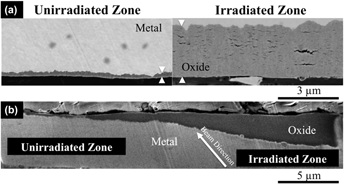Crossref Citations
This article has been cited by the following publications. This list is generated based on data provided by
Crossref.
Was, Gary S.
2015.
Challenges to the use of ion irradiation for emulating reactor irradiation.
Journal of Materials Research,
Vol. 30,
Issue. 9,
p.
1158.
Deng, Ping
Peng, Qunjia
Han, En-Hou
Ke, Wei
Sun, Chen
and
Jiao, Zhijie
2017.
Effect of irradiation on corrosion of 304 nuclear grade stainless steel in simulated PWR primary water.
Corrosion Science,
Vol. 127,
Issue. ,
p.
91.
Was, Gary S.
2017.
Fundamentals of Radiation Materials Science.
p.
951.
Was, Gary S.
2017.
Fundamentals of Radiation Materials Science.
p.
631.
Garner, Alistair
Baxter, Felicity
Frankel, Philipp
Topping, Matthew
Harte, Allan
Slater, Thomas
Tejland, Pia
Romero, Javier E.
Darby, Edward C.
Cole-Baker, Aidan
Gass, Mhairi
and
Preuss, Michael
2018.
Zirconium in the Nuclear Industry: 18th International Symposium.
p.
491.
Yang, Jing
Youssef, Mostafa
and
Yildiz, Bilge
2018.
Electro-chemo-mechanical effects of lithium incorporation in zirconium oxide.
Physical Review Materials,
Vol. 2,
Issue. 7,
Caes, Sebastien
Druyts, Frank
and
Thomas, Peter
2018.
Release and speciation of carbon from Zircaloy-4 in anaerobic and highly alkaline conditions: Comparison of simple immersion and potentiostatic corrosion tests.
Radiocarbon,
Vol. 60,
Issue. 6,
p.
1787.
Reyes, Michael
Wang, Peng
Was, Gary
and
Marian, Jaime
2019.
Determination of dose rate effects on Zircaloy oxidation using proton irradiation and oxygen transport modeling.
Journal of Nuclear Materials,
Vol. 523,
Issue. ,
p.
56.
Zhou, Weiyue
Woller, Kevin B.
Zheng, Guiqiu (Tony)
Stahle, Peter W.
and
Short, Michael P.
2019.
A simultaneous corrosion/irradiation facility for testing molten salt-facing materials.
Nuclear Instruments and Methods in Physics Research Section B: Beam Interactions with Materials and Atoms,
Vol. 440,
Issue. ,
p.
54.
Liu, J.
He, G.
Hu, J.
Shen, Z.
Kirk, M.
Li, M.
Ryan, E.
Baldo, P.
Lozano-Perez, S.
and
Grovenor, C.
2019.
Irradiation-induced amorphization in the zirconium suboxide on Zr-0.5Nb alloys.
Journal of Nuclear Materials,
Vol. 513,
Issue. ,
p.
226.
Zhou, Weiyue
Yang, Yang
Zheng, Guiqiu
Woller, Kevin B.
Stahle, Peter W.
Minor, Andrew M.
and
Short, Michael P.
2020.
Proton irradiation-decelerated intergranular corrosion of Ni-Cr alloys in molten salt.
Nature Communications,
Vol. 11,
Issue. 1,
Wu, Weisong
Ran, Guang
Li, Yipeng
Cong, Shuo
Ye, Chao
Zhang, Ruiqian
and
Sun, Yongduo
2020.
Early corrosion behaviour of irradiated FeCrAl alloy in a simulated pressurized water reactor environment.
Corrosion Science,
Vol. 174,
Issue. ,
p.
108824.
Abel, E. Paige
Domnanich, Katharina
Kalman, Colton
Walker, Wes
Engle, Jonathan W.
Barnhart, Todd E.
and
Severin, Greg
2020.
Durability test of a flowing-water target for isotope harvesting.
Nuclear Instruments and Methods in Physics Research Section B: Beam Interactions with Materials and Atoms,
Vol. 478,
Issue. ,
p.
34.
Wang, Peng
Grdanovska, Slavica
Bartels, David M.
and
Was, Gary S.
2021.
Corrosion behavior of ferritic FeCrAl alloys in simulated BWR normal water chemistry.
Journal of Nuclear Materials,
Vol. 545,
Issue. ,
p.
152744.
Diniasi, Diana
Golgovici, Florentina
Marin, Alexandru Horia
Negrea, Aurelian Denis
Fulger, Manuela
and
Demetrescu, Ioana
2021.
Long-Term Corrosion Testing of Zy-4 in a LiOH Solution under High Pressure and Temperature Conditions.
Materials,
Vol. 14,
Issue. 16,
p.
4586.
Ivanov, Igor
Rspayev, Ruslan
Sapar, Aset
Mustafin, Daulet
Zdorovets, Maxim
and
Kozlovskiy, Artem
2021.
Study of the Effect of Y2O3 Doping on the Resistance to Radiation Damage of CeO2 Microparticles under Irradiation with Heavy Xe22+ Ions.
Crystals,
Vol. 11,
Issue. 12,
p.
1459.
Jones, Christopher
Gass, Mhairi
Preuss, Michael
and
Moore, Katie L.
2021.
Oxide growth and oxygen transport in proton irradiated Zircaloy-4 oxide layers.
Corrosion Science,
Vol. 190,
Issue. ,
p.
109655.
Yang, Jing
Youssef, Mostafa
and
Yildiz, Bilge
2021.
Structure, Kinetics, and Thermodynamics of Water and Its Ions at the Interface with Monoclinic ZrO2 Resolved via Ab Initio Molecular Dynamics.
The Journal of Physical Chemistry C,
Vol. 125,
Issue. 28,
p.
15233.
Schmidt, Franziska
Hosemann, Peter
Scarlat, Raluca O.
Schreiber, Daniel K.
Scully, John R.
and
Uberuaga, Blas P.
2021.
Effects of Radiation-Induced Defects on Corrosion.
Annual Review of Materials Research,
Vol. 51,
Issue. 1,
p.
293.
Armson, Samuel A. J.
Garner, Alistair
Baxter, Felicity
Yankova, Maria S.
Race, Christopher P.
Cole-Baker, Aidan
Riley, Christopher
Preuss, Michael
and
Frankel, Philipp
2021.
Zirconium in the Nuclear Industry: 19th International Symposium.
p.
878.



